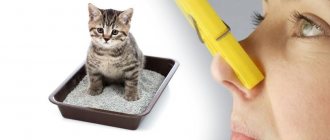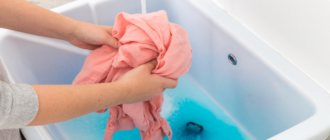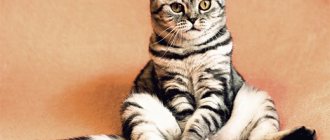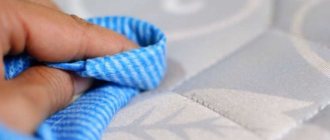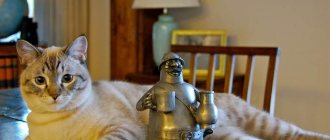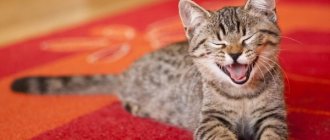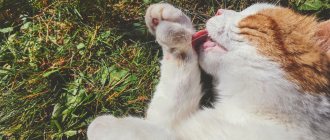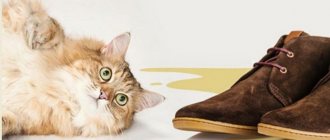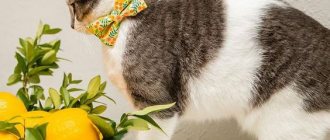A fluffy, purring little ball brings happiness and a lot of positivity to the house.
But a cat is not only a pleasure, but also a care, ignoring which can cause a very unpleasant smell to appear in the apartment. How to remove cat smell in an apartment, what to do if a cat has marked in the house? Proven methods, recommendations and advice from experienced cat lovers will help you solve this rather complex problem and return clean air to your home.
Carpet detergents
The very first surefire way is to use a detergent special for carpeting. They are sold at any household chemical store. As a rule, this product is a concentrated liquid that must be diluted in a certain amount of water to a stable foam.
- In order to definitely get rid of cat urine and odor, this foam must be applied, lightly rubbing, into the desired area and allowed to settle.
- Then you need to take regular baking soda and pour it wet onto our stain. The detergent will remove the urine itself, and the baking soda will absorb the odor as it dries.
- Then use a vacuum cleaner to remove the dried soda. If necessary, this procedure can be repeated, although usually once is enough to get rid of a specific aroma.
Removing Cat Urine from Wood Floors
Cat urine leaves stains on wood that smell bad and can cause the floor to rot.
What we need:
- Paper towels
- Hot water
- 1 cup vinegar
- Hydrogen peroxide
Remove visible urine stains with paper towels. If urine has already soaked into the floor, remove as much of the stain as possible, but do not scrub the floor as you may scratch it.
Then gradually rinse the contaminated area with 1 glass of vinegar. It can be added in larger quantities depending on the degree of contamination. Rinse the surface with 2-3 cups of warm water until the vinegar is removed.
Wipe wet area with paper towels. Next, dampen a paper towel with hydrogen peroxide and gently wipe the surface. Dry it by wiping it again with paper towels.
You can also use this method if your cat has soiled your leather sofa. If possible, remove the leather cover to prevent urine and detergent from getting on the mattress. If the mattress is already stained with cat urine, it must be cleaned in the same way as in the previous option.
Vinegar
Everyone knows that vinegar can remove any unpleasant odors in the kitchen. So why don't we try it in case of unpleasant cat odor? To do this, the stain on the carpet must first be treated with a soap solution and only then poured with a solution of table vinegar diluted with water in a ratio of 1:3. In the first hour, the smell of vinegar will be persistent, but soon it will disappear, taking with it the unpleasant aroma of cat urine.
In this video, the owner will tell you how you can quickly clean up your pet’s puddle and at the same time eliminate unpleasant odors.
Features of working with clothes
It's easy to remove fecal smell from clothes. Before washing, it is important to consider what fabric it is made of.
Methods:
- rinse in a solution of 9% vinegar or citric acid;
- soak for 10 minutes in a solution of table salt;
- rinse in a solution of ammonia and salt.
Do not wipe the stain with wet wipes or try to mask the smell with others. Typically, the opposite effect occurs and the fabric begins to smell like a mixture of aroma and feces.
Stain remover "Vanish"
“Vanish” is also familiar to any housewife. It can be used for small rugs or carpets that can be taken outside to dry. To get rid of both an unsightly stain and an unpleasant odor at home, you simply need to wash the carpet with this product, rinse well, preferably under running water, and let it dry thoroughly. Most likely, this method is more suitable for those who live in a private house.
What to do for prevention?
It is possible to prevent the appearance of an unpleasant cat odor in the apartment if you adhere to certain rules:
- We place the tray only in secluded places. The cat always looks for corners hidden from prying eyes for the toilet.
- We treat the sites of potential “acts of revenge” with special products - cat bleaches. Particular attention should be paid to places where shoes are stored, the rug in front of the bed, and in the bathroom.
- Decorate flower pots with orange peels or pine cones. Cats love to make toilets in flowerpots; pine cones and oranges discourage the pet from marking its territory in this way.
- We change cat litter regularly. The domestic cat is an extremely clean animal that will never defecate in a dirty litter box.
A cat is an animal that does not tolerate violence. In response to beatings and humiliation, the cat will take revenge (mark its territory).
Dry mustard
Even the simplest mustard powder can be used to remove cat urine.
- In order to remove stains and odor, you need to dilute the mustard powder with water to a paste consistency.
- Then this mass is applied directly to the desired place and allowed to sit for a while so that it dries a little.
- Then, using a wet rag, the mush is collected, and finally the area is wiped dry.
- Remaining mustard particles can be collected with a vacuum cleaner.
Cat Mess #4 - Fur
Regardless of whether they have long or short hair, cats shed hair, especially in the spring and fall.
Brush your cat several times a week to remove hairs so they don't get on furniture. Your short-haired cat may need to be groomed less frequently.
Vacuum carpets, upholstery and anything else where hairballs fly around.
Use a sticky pet hair cleaner or a strip of masking tape to remove cat hair from furniture and other surfaces before it gets on your clothes.
Most feline signs are sporadic and can be easily removed. If your cat soils your carpets and has never done this before, or if they constantly soil your carpets, contact your veterinarian. This may be a sign of a health problem that needs attention.
A more complicated method
For this option, you need to get vinegar, baking soda, detergent and hydrogen peroxide. But check in advance somewhere at the edge of the carpet to see if its colors will react with hydrogen peroxide.
- In order to get rid of a stain and an unpleasant “aroma”, you must first pour vinegar on this place and wait until it dries. It’s worth warning right away that the cat smell may intensify, be patient.
- Then pour baking soda onto the stain.
- Then you need to prepare a solution. We take water and hydrogen peroxide in equal proportions, as well as a little detergent, you can use “Fairy” or any other that is in the house.
- The prepared solution must be placed in a spray bottle and sprayed over the soda.
- After everything is dry, you need to vacuum the area.
Cat Mess #2 - Feces (Poop)
Cat feces can be smellier than urine, but they are easier to clean off the floor along with the smell.
Wear gloves. Cat feces can contain parasites that cause toxoplasmosis, a disease that is especially dangerous for pregnant women. If you are pregnant, ask your loved ones to clean up the mess.
Collect feces with paper towels. Dispose of it in the same place you dispose of litter box waste.
Rinse the affected area with cool water and dry with a tissue.
Apply an enzyme-based pet stain and odor remover.
Video “All possible ways to get rid of an unpleasant odor”
In this video you can learn how to eliminate that unpleasant cat urine smell.
Sorry, there are no surveys available at this time.
Was this article helpful?
Thank you for your opinion!
The article was useful. Please share the information with your friends.
Yes
No
X
Please write what is wrong and leave recommendations on the article
Cancel reply
Rate the benefit of the article: Rate the author ( 2 votes, average: 4.50 out of 5)
Discuss the article:
Digestive problems
If your cat's digestive system is unable to digest or absorb the fats and starches in its food, this can result in particularly smelly feces. The technical terms for these digestive problems are improper digestion and improper absorption.
- Solution : Your veterinarian will need to run tests to determine whether your cat is suffering from poor digestion or malabsorption, and will advise you on how to treat each accordingly.
Dental causes of halitosis
When bad breath appears, disease of the teeth or gums is first suspected. Bacteria use leftover food in the mouth to feed themselves. If you brush your teeth incorrectly or completely abandon this procedure, a large amount of plaque accumulates in your mouth. Its rotting causes a repulsive odor. If plaque is not removed for a long time, dense tartar forms, and the stench persists for a long time.
Caries and tooth decay can also cause an unpleasant odor. These are areas where large numbers of microbes accumulate. The breath of people who do not remove decayed tooth roots in a timely manner has a strong smell. A stench can occur when wearing braces, dental plates, dentures, under which food debris accumulates. Any foreign body in the mouth requires additional cleansing.
The condition of the oral cavity is affected by the production of saliva. In some diseases it is not liquid enough. Dryness of the oral mucosa occurs, self-cleaning processes are disrupted and bacterial growth is activated. A similar mechanism works in hot weather or when playing sports, if you actively breathe through your mouth.
Smoking also contributes to the appearance of halitosis. Components of tobacco smoke settle on the teeth and combine with soft plaque. Dry mouth contributes to changes in the composition of saliva and an increase in its viscosity. You can get rid of the smell only by defeating a bad habit.
Treatment of digestive diseases
If the oral cavity is sanitized, but the smell remains, you need to contact a gastroenterologist. Before treating halitosis, an examination will be carried out to find the cause of the disorders. Gastritis and ulcers are associated with poor diet, but inflammation of the gastric mucosa is supported by Helicobacter bacteria. You need to get rid of them comprehensively.
To do this, the doctor will prescribe the following groups of medications:
- antacids – to reduce acidity;
- antibiotics – drugs to kill bacteria;
- healing agents - bismuth nitrate or De-nol to restore the mucous membrane.
In the treatment of cardiac sphincter insufficiency, when the opening between the esophagus and the stomach does not close, antacids are also used, supplemented with prokinetics that improve peristalsis. Treatment of digestive diseases is impossible without following a special diet.
Dry cleaning a sofa from urine: effective means
♦ The smell of human urine is completely removed by professional acid rinses , which, unlike vinegar, do not leave behind a persistent sharp “aroma”. The products contain gentle organic acids (glycolic, valeric, etc.) that break down uric acid salts.
♦ The strong bacterial odor of urine is destroyed with the help of acids and disinfectants . Disinfectants based on quaternary ammonium compounds (QACs) are the least aggressive towards dyes .
♦ The smell of cat and dog urine is eliminated using products with enzymes that accelerate the decomposition process of urea. Enzymes act on substances that are not oxidized by acids and active oxygen.
♦ Urine stains are washed off the surface of the sofa with alkaline solutions that affect the urochrome pigment. Synthetic materials are cleared of yellowness much faster and easier than natural ones.
How you can remove the smell of urine (professional products):
- Chemspec Urine Contamination Treatment, urine odor remover and deodorizer
- Odor neutralizer AXEL-4 Urine Remover ,
- Disinfectant Sepotosan-T ,
- Enzyme product Stink Away Organic ,
- Deodorizer with active enzymes Butchers Break Down ,
- Odor neutralizer (including cat urine) TRASH BUSTER ,
- Arrow Enz-Odours enzymatic remover for odors and stains of biological origin .
Read the blog: “Dry cleaning of upholstered furniture: commandments for dummies and more.”
Bloody diarrhea in a cat
Blood in the stool is an alarming signal. This means that there is inflammation in the pet’s intestines. The mucous membrane peels off and bleeding appears. This type of diarrhea is accompanied by vomiting and high fever. Prolonged diarrhea causes anemia. The pet is getting weaker.
Reasons for this diarrhea:
- helminth infection;
- complications after infectious diseases;
- intoxication;
- bacterial infection;
- toxoplasmosis;
- viral infection;
- intestinal obstruction;
- tumor of the digestive organs;
- volvulus, hernia;
- disease of the large intestine.
If blood appears in the stool, contact your veterinarian immediately.
What happens to urine in the upholstery and filling of the sofa
When urine gets on the upholstery of a sofa, it is quickly absorbed into the structure of the fabric and into the top layer of the filler. The speed of this process depends on the absorbency of the materials and the presence or absence of moisture-proof layers/impregnations.
Within a few days after the “incident,” urine evaporates and loses up to 96% of its volume, which is water. Precipitated metabolic products remain in the materials - uric acid salts, urea, pheromones and other water-insoluble substances. The pH of urine shifts from acidic (pH 5-6) to alkaline (pH 9-10).
The main source of the foul “aroma” is uric acid salts. The characteristic odor of ammonia is given to the components of urine by bacteria that enter biological secretions from the outside and/or are initially contained in them (present in the urine of sick elderly people). The yellow color of the urinary spot is given by urochromes - derivatives of bile pigments.
When in contact with water, the components of uric acid form highly volatile organic compounds, thiols (mercaptans), which emit a disgusting stench. To neutralize it, dry cleaners use special odor absorbers.
Read in the blog: “Even dry cleaners fail: 6 problems when dry cleaning upholstered furniture.”
About your pets' excrement
In this article, we'll talk about a sensitive topic... your pet's excrement, aka poop.
Any encyclopedia will tell you - feces (faeces; synonyms: feces, excrement) - the contents of the distal part of the large intestine, released during defecation.
Normally, cats have bowel movements once or twice a day, the stool is formed, slightly moist and soft, dark brown in color, there is no mucus, blood or undigested food in it. Ideally, the size of the stool should be significantly smaller than the amount of food on the plate (25%). When there is less output than input, the cat extracts more nutrients from the food. Large stools are caused by the presence of undigested filler in feed such as corn and other plant products.
Only one type of feces will allow you to determine how the digestive processes are going, whether any pathology occurs, and will make it clear about the presence of inflammatory processes.
But in order to understand this, let’s look at what criteria are taken into account to evaluate the result of a cat going to the litter box for big matters, precisely those criteria that we can personally evaluate and, if necessary, contact a veterinary clinic for qualified help. There are only three of them: consistency or shape, color and smell.
Let's start in order:
CONSISTENCY OF STOOL
The consistency depends on the amount of water, fiber, mucus and fat in the stool. Dense, well-formed feces are excreted in healthy animals.
Normally, your pet’s output is formed, not crumbling, having the appearance of a soft “sausage” of normal thickness with a smooth surface or a denser “sausage” type No. 3 and No. 4 on the Bristol scale (see figure).
Hard, dry stool can mean stagnation of stool in the large intestine, megacolon, it has the appearance of a lumpy “sausage” type No. 2 on the Bristol scale. Feces become hard when the rate of movement of chyme through the intestines decreases.
“Sheep feces” in the form of separate dense small lumps, type No. 1 on the Bristol scale, may indicate insufficient water intake, especially when eating dry food in unlimited quantities, and, as an option, a spastic condition of the intestines, namely spastic colitis.
Wet, beginning to lose shape type No. 5 on the Bristol scale means increased motility of the gastrointestinal tract as a result of high fiber intake in food.
Pasty, unformed feces can occur with strong gastrointestinal peristalsis, infections, poisoning type No. 6 on the Bristol scale.
Watery stool without solid inclusions, type No. 7 on the Bristol scale, indicates strong intestinal motility, impaired (cessation) absorption, acute gastrointestinal infections, and severe intoxication.
Feces have a ribbon shape in the presence of hemorrhoids, spasm of the rectal sphincter, anal fissure, or rectal tumor. Due to the narrowing of the anus, it takes the shape of a long, thin, soft “sausage.”
COLOR OF FOCUS
The color of stool is due to the content of stercobilin. Stercobilin (stercobilm) is a brownish-reddish pigment formed during the metabolism of the bile pigments biliverdin and bilirubin, which, in turn, are formed from hemoglobin. Subsequently, stercobilin is excreted from the body in urine or feces.
The color of stool is normally brown, normally it becomes yellow with a milk diet, dark brown with purely meat feeding.
In young animals, milk feeding promotes a light (yellowish-brown) coloration. Some plant foods and medications can change the color of stool (beets, blueberries, bismuth, iron, etc.).
Black or tarry color of feces acquires when there is bleeding in the anterior gastrointestinal tract (stomach, duodenum and small intestine). The reddish color is due to the presence of bleeding in the posterior gastrointestinal tract (colitis with ulceration).
Light brown - with accelerated evacuation from the colon, vegetable feeding.
Green – with the content of bilirubin, biliverdin, increased peristalsis.
Light yellow – with pancreatic insufficiency, fermentative dyspepsia.
Gray-white - acholic feces when bile does not enter the intestines.
SMELL OF FOCUS
The smell is due to the presence of protein breakdown products (indole, skatole, phenol, etc.), which intensifies under rotting conditions with an abundance of protein foods. Prolonged retention of feces (constipation) leads to the absorption of gases, and the odor may almost completely disappear.
Normally, it is specific and unsharp.
A putrid odor appears with insufficiency of gastric digestion, putrefactive dyspepsia, and ulcerative colitis.
Fetid (smell of rancid oil) due to impaired secretion of lipase by the pancreas, lack of bile flow.
The sour smell is caused by fermentation processes in the large intestine and impaired absorption of fatty acids in the small intestine.
And so, what should an ideal poop look like - a good stool should be dark brown, dense, smooth and have a normal smell - the smell of feces. The consistency and texture should be the same throughout the entire load of stool, and it should be easy to remove completely.
